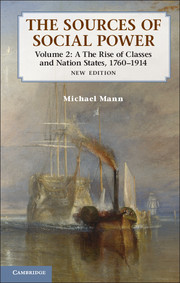Book contents
- Frontmatter
- Contents
- Preface to the new edition
- Preface
- 1 Introduction
- 2 Economic and ideological power relations
- 3 A theory of the modern state
- 4 The Industrial Revolution and old regime liberalism in Britain, 1760–1880
- 5 The American Revolution and the institutionalization of confederal capitalist liberalism
- 6 The French Revolution and the bourgeois nation
- 7 Conclusion to Chapters 4–6: The emergence of classes and nations
- 8 Geopolitics and international capitalism
- 9 Struggle over Germany: I. Prussia and authoritarian national capitalism
- 10 Struggle over Germany: II. Austria and confederal representation
- 11 The rise of the modern state: I. Quantitative data
- 12 The rise of the modern state: II. The autonomy of military power
- 13 The rise of the modern state: III. Bureaucratization
- 14 The rise of the modern state: IV. The expansion of civilian scope
- 15 The resistible rise of the British working class, 1815–1880
- 16 The middle-class nation
- 17 Class struggle in the Second Industrial Revolution, 1880–1914: I. Great Britain
- 18 Class struggle in the Second Industrial Revolution, 1880–1914: II. Comparative analysis of working-class movements
- 19 Class struggle in the Second Industrial Revolution, 1880–1914: III. The peasantry
- 20 Theoretical conclusions: Classes, states, nations, and the sources of social power
- 21 Empirical culmination – over the top: Geopolitics, class struggle, and World War I
- Appendix: Additional tables on state finances and state employment
- Index
- References
15 - The resistible rise of the British working class, 1815–1880
Published online by Cambridge University Press: 05 July 2013
- Frontmatter
- Contents
- Preface to the new edition
- Preface
- 1 Introduction
- 2 Economic and ideological power relations
- 3 A theory of the modern state
- 4 The Industrial Revolution and old regime liberalism in Britain, 1760–1880
- 5 The American Revolution and the institutionalization of confederal capitalist liberalism
- 6 The French Revolution and the bourgeois nation
- 7 Conclusion to Chapters 4–6: The emergence of classes and nations
- 8 Geopolitics and international capitalism
- 9 Struggle over Germany: I. Prussia and authoritarian national capitalism
- 10 Struggle over Germany: II. Austria and confederal representation
- 11 The rise of the modern state: I. Quantitative data
- 12 The rise of the modern state: II. The autonomy of military power
- 13 The rise of the modern state: III. Bureaucratization
- 14 The rise of the modern state: IV. The expansion of civilian scope
- 15 The resistible rise of the British working class, 1815–1880
- 16 The middle-class nation
- 17 Class struggle in the Second Industrial Revolution, 1880–1914: I. Great Britain
- 18 Class struggle in the Second Industrial Revolution, 1880–1914: II. Comparative analysis of working-class movements
- 19 Class struggle in the Second Industrial Revolution, 1880–1914: III. The peasantry
- 20 Theoretical conclusions: Classes, states, nations, and the sources of social power
- 21 Empirical culmination – over the top: Geopolitics, class struggle, and World War I
- Appendix: Additional tables on state finances and state employment
- Index
- References
Summary
Theories of working-class movements
Most histories of working-class movements begin in Britain. During the nineteenth century, Britain was the only industrial nation, with the only large working class. Remarkably, as Table 15.1 indicates, there were more workers in manufacturing than in agriculture as early as the Battle of Waterloo, in 1815, virtually a hundred years earlier than in any other major Power (as Table 19.1 also reveals).
The early emergence of British labor made it unique. When, at the beginning of the twentieth century, other major Powers were industrialized, with comparably sized labor forces, the nature of industrialization, of the state, and of class had been transformed. What happened in Britain and in Chartism to the first proletariat was not repeatable. Nonetheless this first working class was then regarded – and often still is – as the prototype of the future. Britain housed Marx and Engels (who managed a factory in Stockport). Their theory of the working class drew principally on the British experience and has influenced virtually all subsequent writers. They argued four principal theses:
Capitalism diffused a qualitative divide between capital and labor throughout civil society as similar “universal classes.”
Manufacturing capitalism massified the labor force, making workers collectively interdependent at the point of production and in the labor market. Workers became interdependent “collective laborers,” forming trade unions and undertaking collective class action.
Similarity and interdependence are reinforced outside of work by dense worker communities capable of autonomous social and cultural organization.
These three capacities for collective action generate class politics and a socialist party capable of capturing political power, if necessary by revolution.
- Type
- Chapter
- Information
- The Sources of Social Power , pp. 510 - 545Publisher: Cambridge University PressPrint publication year: 2012



